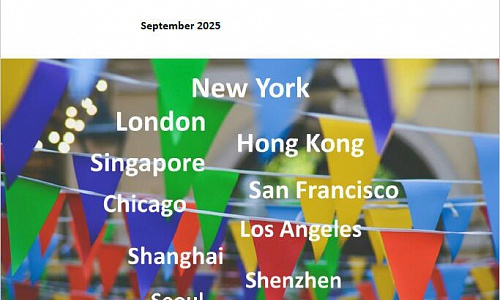Before 2010, no one could have imagined that this remote area would soon become an international financial hub connecting Hong Kong and the mainland. By 2015, the expected output volume of this area is 50 billion yuan ($7.9 billion, 6.3 billion euros), while in 2020, the amount is expected to triple to 150 billion yuan.
Qianhai, the 15-square-kilometer area in the western coast of Shenzhen, has been in the limelight recently after it was announced that it would be the testing ground for the next set of financial innovations in China.
Unlike previous financial innovations in Wenzhou of Zhejiang province, which aimed at transforming private capital to industrial capital, Qianhai's project focuses on accelerating the internationalization of renminbi by establishing closer linkage between Shenzhen and Hong Kong, and strengthening Hong Kong's role as an offshore business center for renminbi.
"Financial liberalization, including the promotion of renminbi as an international currency, is the centerpiece of the initiative. It reveals China's broad reform agenda that can eventually be extended nationwide," says a recent research report published by Citibank.
Guo Wanda, executive vice-president of China Development Institute in Shenzhen, says: "It is an important stepping stone for China to accelerate renminbi internationalization. Qianhai is like a pioneer for the mainland's efforts in gradual achievement of full renminbi convertibility."
According to the official approval given by the State Council on June 27, Shenzhen's Qianhai will be known as Qianhai Shenzhen-Hong Kong Modern Service Industry Cooperation Zone. The State Council has given "national strategic importance" to the reform.
Zhang Xiaoqiang, vice-minister of the National Development and Reform Commission, says that the pilot measures to be launched in Qianhai had been carefully designed to reflect Hong Kong's position in the area's development and had also taken into consideration Hong Kong's opinion and demand during the policymaking process.
The series of pilot measures will be in areas such as finance, taxation, legal, human resources, education, healthcare and telecommunications.
Companies in Qianhai will receive help from the central government for issuing yuan bonds in Hong Kong, while the Hong Kong equity investment fund will be allowed to develop in new ways in Qianhai.
The entry thresholds for financial institutions from Hong Kong will also be lowered under the Closer Economic Partnership Agreement.
"When the idea of developing Qianhai area was first put forward, many people were concerned that Qianhai might be a threat to Hong Kong's financial industry once it is fully developed," Guo says. "As a matter of fact, there is nothing to worry about. Qianhai is designed to strengthen Hong Kong's role in the global market, since it focuses on innovation of RMB internationalization."
The Hong Kong Monetary Authority has welcomed the plans to facilitate cross-border use of the yuan and its flow between the mainland and Hong Kong.
"We believe that cooperation between Hong Kong and Qianhai can create a win-win situation for both," says Peter Pang, deputy chief executive of the HKMA. "Hong Kong is developing into a global yuan offshore center. Qianhai's innovation in yuan's cross-border business can be another engine for Hong Kong's yuan offshore business."
Hong Kong is the largest offshore holder of the yuan. According to statistics from the HKMA, Hong Kong had yuan worth 673.7 billion yuan by the end of May. It is also the largest offshore yuan bond market. A total of 254.4 billion yuan bonds were issued since 2007.
"We are glad to see the central government is contemplating measures to allow Hong Kong's banks to extend yuan loans to companies and projects in Qianhai, and we hope that the usage of the loans can be enlarged to other areas of the mainland," Pang says.
On July 16, 37 companies, including 12 Hong Kong companies, signed agreements with Qianhai Administration Bureau, worth 220 billion yuan. Eighteen of them are financial institutions including Hang Seng Bank, HSBC and Citibank.
Anita Fung, CEO of HSBC Hong Kong, says that Qianhai's exploration in luring cross-border yuan will be a new engine for the internationalization of yuan.
"HSBC, together with the banking industry in Hong Kong, will utilize its experience in offshore yuan business to the fullest and work out professional products and services for mainland companies," she says.
According to Fung, HSBC's offshore yuan cross-border trade settlement has so far covered 59 markets in the world, accounting for three-fourths of total markets the company has covered.
"HSBC has the broadest yuan trade service network among foreign-funded banks. I am sure that with our participation in Qianhai, a better environment, which can stimulate the growth of entity economies, will be built," she says.
A detailed regulation of what and how innovative financial policies will be applied in Qianhai has not been made available yet, but financial institutions in Hong Kong have started to look forward to the future benefits and a bolder innovation in Qianhai is expected by all parts.
Guan Yanping, vice-chairman and governor of Hang Seng Bank (China), says that Hang Seng Bank is looking forward to cooperation with Qianhai, and hopes Qianhai can lower thresholds for foreign banks to conduct mixed operation in the mainland.
Hang Seng Bank's business areas in Hong Kong include banking, securities, funds and insurance, but up to now, it does not have much space in mixed operation in the mainland.
Guan says the company will come out with innovative products in Qianhai to attract more cross-border yuan business.
Guo from the China Development Institute says apart from cross-border yuan loans, foreign banks are expecting more business opportunities in the mainland.
If they are allowed to conduct mixed operations in Qianhai, it would be an unprecedented development opportunity for them, he says. "However, mixed operation is complicated. It will take a long time for relevant authorities to sort this question out, so the progress won't be achieved within a short time."
Xie Yonghai, executive vice-president of BOC International Holdings, says a super monetary authority should be established in Qianhai to conduct mixed financial operations, with banking, securities and insurance as sub-divisions.
"As an experimental zone for China's financial industries, Qianhai should not stick to the old tradition in the mainland that puts industries under the financial category separately, as it will hamper financial innovation. It should join the international trend that allows experiments in mixed operation," he says.
Academics also picture a colorful future for Qianhai, with some bold recommendations.
Chan Yanchong, associate professor at the Department of Management Sciences in the City University of Hong Kong, says that the Hong Kong Exchanges and Clearing, which operates the Hong Kong stock exchange, should open a subsidiary in Qianhai.
"Actually, every brokerage and bank in Hong Kong should have subsidiaries in Qianhai", so that mainland investors can access and invest in Hong Kong's stock market from Qianhai, he says.
In this way, Chan says, the money that is used to invest in Hong Kong securities technically stays onshore all the time, making it safer and easier to control.
Though the blueprints promise a bright future for Qianhai, there are still some questions that linger.
One of the most frequently asked questions is how Qianhai is going to treat financial institutions from other regions, as its innovative financial policies are not exclusive to those from Hong Kong. If all foreign institutions are to be treated equally, how does Qianhai ensure its role of facilitating Hong Kong's position as an yuan offshore center?
In recent years, Singapore and London have also been trying to take positions as offshore centers for yuan trading.
According to Guo, Hong Kong has around 600 billion offshore yuan, while the figure is 100 billion yuan for Singapore and around 10 billion for London.
"Of course, Qianhai is open to every eligible foreign institution," says Wang Jinxia, liaison director of Qianhai Administration Bureau.
"If financial institutions from Singapore and London are interested in Qianhai, they are also welcome. However, Hong Kong's advantage in becoming the yuan offshore center is incomparable."
According to Wang, Qianhai has strict standards to define eligible companies, which can enjoy the innovative policies.
For the first phase of construction, Qianhai is planning to build up a functional area of 2.5 square kilometers.
The thresholds for companies to enter this area, according to Wang, are those capable of holding a working area of more than 100,000 square meters with more than 10 billion yuan of total investment, and can provide annual revenue of more than 600 million yuan in Qianhai in the second year.
"The standards are quite steep and ensures that every company which comes to Qianhai passes muster. The plan has been proposed to the National Development and Reform Commission, and hopefully will be approved by the end of this year," Wang says.
The work on filling the sea will be finished by the end of this year, and then construction of a traffic hub will start.
"2013 is the beginning of the second step of Qianhai construction. A total of 12 subway lines will be built and by 2016, it will take only 13 minutes to take a subway from Qianhai to the Hong Kong International Airport," he says.
Other than financial areas, Beijing will also support Hong Kong's educational institutions to establish schools in Qianhai. Medical institutions in Hong Kong are also being encouraged to set up hospitals there, while telecom companies from Hong Kong have also been urged to set up ventures in Qianhai.
China Daily 09/07/2012 page12









